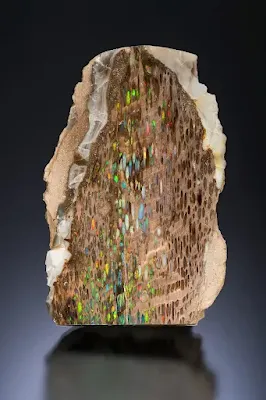Conk Opal: The Wood That Turned to Gemstone
Conk opal is a rare type of opal that is found in the Virgin Valley region of Nevada. It is formed when opal replaces the cells of fossilized wood. The opal fills the cavities in the wood, creating a unique and beautiful pattern. Conk opal is prized by collectors and jewelers for its rarity and its beauty.
Conk opal is typically found in small pieces, but larger specimens can be found. The color of conk opal can vary, but it is most commonly found in shades of brown, yellow, and orange. Conk opal is also known for its play of color, which is created by the different ways that light is reflected off of the opal's surface.
 |
| Opalized "conk" wood from Royal Peacock Opal Mine, Virgin Valley, Nevada. Photo: Invaluable, LLC. |
Conk opal is a rare and beautiful gemstone that is prized by collectors and jewelers alike. It is a unique and eye-catching stone that adds a touch of elegance to any setting.
The name "conk" comes from the Latin word "concha", which means "shell".
Facts about Conk Opal
Conk opal is formed when opal replaces the cells of fossilized wood. This process can take millions of years.
Conk opal is typically found in the Virgin Valley region of Nevada, but it can also be found in other parts of the world, such as Australia and Mexico.
How Did Conk Opal Form
Conk opal is thought to have formed millions of years ago, when the Virgin Valley region was a swamp. The swamp was home to a variety of trees, including Cryptomeria, a relative of the Sequoia. The ash mixed with water to form a lake, and the trees that grew around the lake died and fell into the water. The wood was then buried by more ash and sediment. Over time, the wood decayed, leaving behind empty cells. These cells were then filled with opal, creating the conk opal that we see today.
Virgin Valley opal is often found in the form of limbs, twigs, and even pinecones.
 |
| Opalized "conk" wood from Royal Peacock Opal Mine, Virgin Valley, Nevada. Photo: LGF Foundation, Inc. |
Since 1981, the Royal Peacock Opal Mine has been open to the public as a pay-to-dig mine. You can read about it here.








